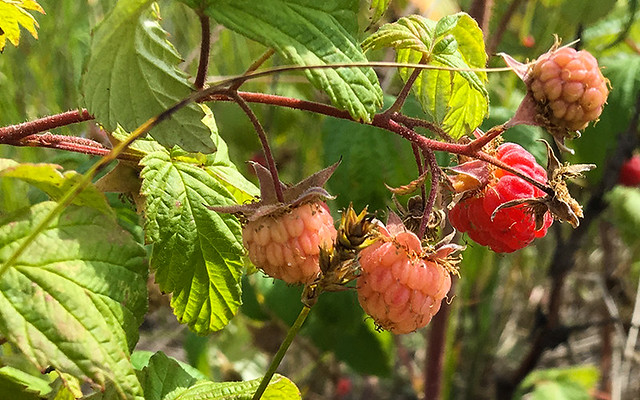Rubus idaeus (raspberry, also called red raspberry or occasionally as European raspberry to distinguish it from other raspberries) is a red-fruited species of Rubus native to Europe and northern Asia and commonly cultivated in other temperate regions.[2][3]
A closely related plant in North America, sometimes regarded as the variety Rubus idaeus var. strigosus, is more commonly treated as a distinct species, Rubus strigosus (American Red Raspberry), as is done here.[4] Red-fruited cultivated raspberries, even in North America, are generally Rubus idaeus or horticultural derivatives of hybrids of R. idaeus and R. strigosus; these plants are all addressed in the present article.
Plants of Rubus idaeus are generally perennials which bear biennial stems (“canes”) from a perennial root system. In its first year, a new, unbranched stem (“primocane”) grows vigorously to its full height of 1.5-2.5 m (5.0-8.3 feet), bearing large pinnately compound leaves with five or seven leaflets, but usually no flowers. In its second year (as a “floricane”), a stem does not grow taller, but produces several side shoots, which bear smaller leaves with three or five leaflets. The flowers are produced in late spring on short racemes on the tips of these side shoots, each flower about 1 cm (0.4 inches) diameter with five white petals. The fruit is red, edible, and sweet but tart-flavoured, produced in summer or early autumn; in botanical terminology, it is not a berry at all, but an aggregate fruit of numerous drupelets around a central core. In raspberries (various species of Rubus subgenus Idaeobatus), the drupelets separate from the core when picked, leaving a hollow fruit, whereas in blackberries and most other species of Rubus, the drupelets stay attached to the core.[5][6][7][8]
As a wild plant, R. idaeus typically grows in forests, forming open stands under a tree canopy, and denser stands in clearings. In the south of its range (southern Europe and central Asia), it only occurs at high altitudes in mountains.[7] The species name idaeus refers to its occurrence on Mount Ida near Troy in northwest Turkey, where the ancient Greeks were most familiar with it.[8]
(From: Wikipedia, April 2017)




